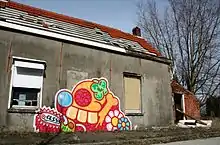Doel
Doel is a subdivision of the municipality of Beveren in the Flemish province of East-Flanders in Belgium. It is located near the river the Scheldt, in a polder of the Waasland. Since 1965, there have been plans to extend the Port of Antwerp into Doel and demolish the village, however protests have caused a stalemate.
Doel | |
|---|---|
Village | |
_and_the_nuclear_power_plant_cooling_tower_in_Doel%252C_Belgium_(DSCF3859).jpg.webp) Doel: Power plant and 17th century windmill on the Scheldedijk | |
 Doel Location in Belgium | |
| Coordinates: 51°19′29″N 4°15′31″E | |
| Country | |
| Region | Flemish Region |
| Province | East Flanders |
| Municipality | Beveren |
| Area | |
| • Total | 25.60 km2 (9.88 sq mi) |
| Population (2014)[2] | |
| • Total | c.20 (unofficial) |
| Time zone | CET |
History
The first mention of the village dates from 1267, when "The Doolen" name is first mentioned.[3] Until the 18th century the village was an island surrounded by purposefully flooded land,[4] with the remainder, north of the village, known as "The Drowned Land of Saeftinghe".[5] The "Eylandt den Doel" is completely surrounded by old seawalls. The dike encloses the hamlets of , "Saftingen", "Rapenburg" and "Ouden Doel" (Olden Doel).[6]
The Doel polder site is unique to Belgium and dates back to the Eighty Years War (1568-1648). The typical checkerboard pattern dates from 1614, when these geometric farmlands were first mapped, and they have seen little change over the years. This fact makes the village a rare example of regional urbanization.[4] The village has many historic buildings, including the oldest stone windmill of the country (1611), and the only windmill on a sea wall. The Baroque Hooghuis (1613) that is associated with the entourage and holdings of the famous 17th century Antwerp painter, Peter Paul Rubens.[7]
Some of the other historical and cultural buildings in the town area are the "Reynard Farm" (De Reinaerthoeve), with a monumental farmhouse and barn. "De Doolen" is a historic school. "De Putten", or "The Wells", is a peat extraction area and has an historically unique 18th-century farmstead and inn site "The Old Hoefyzer", with one of the last remaining historic barns.[8]
Doel Nuclear Power Station
Electrabel-owned Doel Nuclear Power Station is located to the north of the village of Doel. Its four reactors can produce a total output of 2.9 GW of electricity for consumers in Belgium, France and the Netherlands.[9]
Doel demolition


Since 1965, there have been plans to enlarge the Port of Antwerp and demolish the village of Doel to be replaced with petrochemical industry. This has seen many people having to sell their homes to the development corporation of that enlargement, however some people resisted the plans. In the middle of the 1980s, the plans were halted only to be revived in 1995. Many historic buildings have already been demolished. As of 1 September 2009, people are no longer allowed to live in the village.[10]
An author says in one magazine article concerning the demolition of the village, "The Belgian village of Doel was reclaimed from the river Scheldt at the beginning of the 17th century. Three hundred years later and the village that would grow behind the sea wall is under threat. The threat comes not from a failing dyke or an unexpectedly sudden rise in water levels, but rather from the expanding Port of Antwerp and its insatiable need for more and more land along the Scheldt in which to grow. Now, Doel, the last of the Belgian polder villages on the banks of the Scheldt near the North Sea, faces possible demolition. The construction of a large dock and container terminal capable of receiving deep-sea ships is already underway on a site immediately next to the village, and the Port Authority proposes building a second one where the village now stands."[11]
A memorial to British soldiers killed nearby during World War II was removed from the town square during the early morning hours in 2011, according to a BBC report.[12]
See also
References
- "Doel". Agentschap Onroerend Erfgoed (in Dutch). Retrieved 20 October 2020.
- "Doel: The ghost town graffiti artists tried to save". BBC News. Retrieved 20 October 2020.
- "Van de Doolen naar den Doel". De Standaard. Retrieved 20 October 2020.
- "A unique village by the river Scheldt" (in Dutch). Retrieved 20 October 2020.
- "Het Verdronken Land van Saeftinghe". Historien (in Dutch). Retrieved 20 October 2020.
- "20190617 FAQ infomarkt ontwerp voorkeursbesluit" (PDF). Havengebied Antwerpen (in Dutch). Retrieved 20 October 2020.
- Doel2020. "A unique village by the river Scheldt."
- "Leven in erfgoed". Doel 2020 (in Dutch). Retrieved 20 October 2020.
- "Planned and unplanned outages affecting generation units". Elia Group (in Dutch). Retrieved 20 October 2020.
- "De teloorgang van een Scheldedorp". VRT (in Dutch). Retrieved 20 October 2020.
- Kevin Saidler. "Bulldozing Belgium: A photo essay." Things Magazine. Date not given.
- "Belgian village in uproar as UK war memorial relocated." by Matt Cole
External links
| Wikimedia Commons has media related to Doel. |